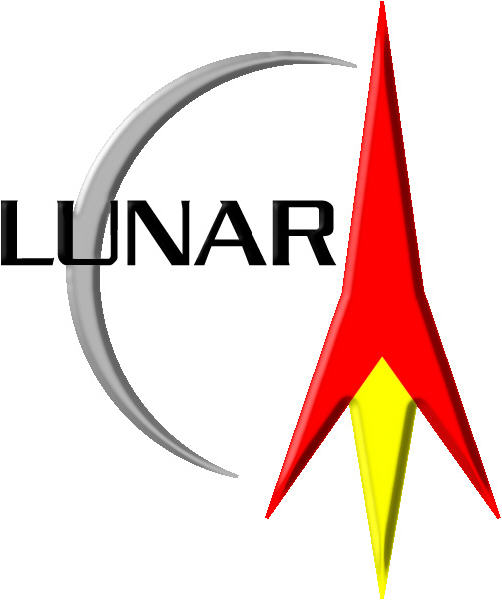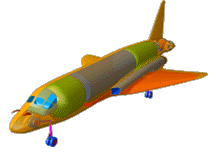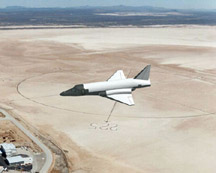 LUNAR’clips
2003
Volume 10, Number 3
LUNAR’clips
2003
Volume 10, Number 3
 LUNAR’clips
2003
Volume 10, Number 3
LUNAR’clips
2003
Volume 10, Number 3
Livermore Unit of the National Association of Rocketry May/June 2003
Copyright © 2003 by LUNAR, All rights reserved.
At a media event in Mojave, California on Friday, April 18, more than 300 guests witnessed what Rutan has labeled the "world's first private space program", as Burt Rutan unveiled his future manned spacecraft, a space-faring vehicle called SpaceShipOne.

Burt Rutan was the first person to register for the X PRIZE, shortly after its formation in May 1996. "The X PRIZE was our main inspiration for building SpaceShipOne," stated Rutan. "Our goal is to be the first private spaceship to fly private astronauts to 100KM. I hope our progress will inspire others to follow in our footsteps."
"We're going to space because that's where the view is," continued Rutan. "This event is not about dreams, predictions or mockups. We are showing actual flight hardware: an aircraft for high-altitude airborne launch, a flight-ready manned spaceship, a new, ground-tested rocket propulsion system and much more. This is not just the development of another research aircraft, but a complete manned space program with all its support elements."

Burt Rutan is a legend in the aircraft business, known principally for designing and flying the Voyager, which today hangs in the National Air and Space Museum in Washington, DC. Voyager was the first plane to fly around the world without refueling.
Rutan and his Scaled Composites team () may be the most well-known entrants into the X PRIZE, but they face stiff competition from many of the other 23 entrants. "We congratulate Burt," said Brian Feeney of Canada's daVinci team. "This helps to further legitimize the effort for us all." Teams from Argentina, Canada, Israel, Romania, Russia, UK, and the United States are entered into the X PRIZE competition; a complete listing and profiles of their spaceships can be found at www.xprize.org.
The X PRIZE competition launch system proposed by Scaled Composites (SC) consists of two stages: a carrier aircraft, the White Knight, and a second stage rocket, SpaceShipOne (SS1). The White Knight is a manned, twin-turbojet research aircraft intended for high-altitude missions. The design mission of White Knight is to provide a high-altitude airborne launch of a manned suborbital spacecraft, SS1. The White Knight is equipped to flight-qualify all the spacecraft systems, except rocket propulsion. The White Knight's cockpit, avionics, electronic control system, pneumatics, trim servos, data system, and electrical system components are identical to those installed on SS1. The White Knight's high thrust-to-weight ratio and enormous speed-brakes allow the Astronauts in training to practice space flight maneuvers like boost, approach and landing, with a very realistic environment. Thus, the aircraft serves as a high-fidelity, moving-base simulator for SS1 pilot training. SpaceShipOne (SS1) is a three-place, high altitude research rocket, designed for sub-orbital flights to 100 km altitude. The unique configuration allows aircraft-like qualities for boost, glide, and landing. During descent, the ship's empennage converts (using pneumatic-actuated 'feather') to a stable, high-drag shape for atmospheric entry. This "Care- Free" configuration allows a 'hands-off' reentry and greatly reduces aero/ thermal loads. Designed for a 'shirt- sleeve' environment, the 60" the White Knight releases SS1 and pulls away from the undocked spacecraft.
"Our plan involves flight in a 3-place spaceship, initially attached to a turbojet launch aircraft while climbing for an hour to 50,000 feet, above 85% of the atmosphere. The spaceship then drops into gliding flight and fires its rocket motor while climbing steeply for more than a minute, reaching a speed of 2,500 mph. The ship coasts up to 100 km (62 miles) altitude, then falls back into the atmosphere. The coast and fall are under weightless conditions for more than three minutes. During weightless flight, the spaceship converts to a high-drag configuration to allow a safe, stable atmospheric entry. After the entry deceleration which takes more than a minute, the ship converts back to a conventional glider, allowing a leisurely 17 minute glide from 80,000 feet altitude down to a runway where a landing is made at lightplane speeds." says Burt Rutan
For more information on this team, see www.scaled.com
This team is led by Mitchell Burnside Clapp, from Solvang, California, and they plan to start with a two-seat vehicle (Pathfinder) and then move on to a four-seat vehicle (Pioneer XP). The key idea behind the Pioneer rocketplane called Pathfinder is that it can be aerially "refueled" from a tanker such as the US Air Force KC-135. This has caused some people to describe it as 'stage-and-a-half' rather than a true Single Stage to Orbit (SSTO) vehicle. The Rocketplane will take off and land horizontally from a large commercial runway.

The Pathfinder is a sub-orbital propellant-transfer spaceplane. The configuration is a two-seat fighter-bomber-sized aircraft powered by two turbofan engines and one kerosene/oxygen-burning RD-120 rocket engine. The Pathfinder aircraft is designed to take off with its turbofan engines, and climb to approximately 30,000 feet where it meets a tanker aircraft. The tanker then transfers about 150,000 pounds of liquid oxygen to the Pathfinder spaceplane. After disconnecting from the tanker, the spaceplane starts its rocket engine and climbs to 70 mile altitude and Mach 15. By this time, the spaceplane is outside the atmosphere and can open its payload bay doors, releasing the payload with a liquid rocket upper stage, which delivers the payload to its intended low-earth orbit. The doors are then closed and the Pathfinder aircraft reenters the atmosphere. After slowing down to subsonic speeds, the turbofan engines are restarted and the aircraft is flown to a landing field.

The Pioneer XP is a four-seat fighter-sized vehicle powered by two jet engines and two rocket engines, enabling it to reach altitudes of 350,000 feet. The XP will operate from ordinary airfields within the well-established rules and practices for experimental aircraft. The XP does not use any launch assist: No airdrop, no towing, no aerial propellant transfer, and no magical engines. Of course, it doesn't have all that much performance either: only about 6,000 ft/s at 350,000 feet altitude.
Safety, existing aircraft rules, and the constraints of cost and schedule force the Pioneer Rocketplane team to select oxygen and kerosene as the main propellants, to use a simple and reliable propellant feed system, to employ safe, already certified aircraft components, and to plan on an incremental flight test approach.
For more information on the Pioneer team, see www.rocketplane.com
To win the X PRIZE, private teams must finance, build and fly a three-person spacecraft 100 km (62 miles) to the edge of space, return safely, and then demonstrate the reusability of their vehicle by flying it again within two-weeks. A winner of the X PRIZE is expected within the next 12-24 months. The goal of the X PRIZE is to make space travel frequent and affordable for the general public.
All content is the responsibility of LUNAR.
If you have comments or suggestions regarding these web pages,
please contact the 
Copyright © 1992 - 2025 LUNAR